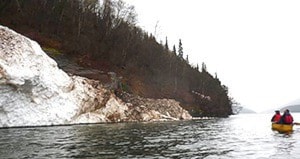Ten canoeists learned the value of rescue and survival skills on a recent Bowron Chain trip.
It was on a 5-day, May, shoulder season Bowron Chain trip. Winter was taking its own sweet time to leave the area and some of the lakes were still frozen. For this reason the group chose to travel on the West Side of the Chain where they knew the lakes were open.
On day three they decided not to break camp at Sandy Lake and divided into three smaller groups.
Four of the fellows wanted to circumnavigate all of Sandy Lake and hike into Hunter Lake in the process.
Two of the fellows wanted to explore Sandy Lake’s north shore in search of the big cedar trees.
The remaining four wanted to paddle to Turner Creek on Lanezi Lake where they had been told the campground was still covered in deep snow. One of these fellows was visiting from Ontario and everyone wanted him to see the majestic snow-covered mountains that rim Lanezi Lake.
There are several very dramatic avalanche chutes on Lanezi. These fill up with snow during the winter and in the early spring the snow comes sliding and crashing down into the lake. During a big snow year like this one had been, these chutes take on the appearance of mini glaciers.
At one particularly beautiful chute the two canoes stopped and the bow paddler in each canoe took out his camera. The canoes, side by side, one a little ahead of the other, were parallel to the very steep rock face, about 15m out from shore. Just as one of the fellows “clicked” his iPhone there was a cracking sound and a huge portion of the ice face broke off.
The crash sent out a large wave of water and the canoes nearly capsized. Immediately both canoes tried to turn away from the oncoming wave, the more nimble Prospector designed with some rocker was successful while the longer and flatter Tripper, designed for speedy lake travel but not for quick turning was hit broadside by a second wave and flipped, both men in that canoe were in the freezing water.
It took about seven minutes. There was an initial impulse to try and make it to shore but there was no shore, just a steep rock face and besides at that temperature as one of the men stated, “your legs don’t work very well.” Our group had talked about rescues earlier during the trip and the importance of staying with your boat.
The fellows in the Prospector started the canoe-over-canoe rescue procedure, the stern paddler was the most experienced and he took control, guiding everyone in the process. The Tripper was emptied of water, soon both of the drenched paddlers were back in their canoe and the floating gear was gathered from the lake. The only real casualty was the propane stove, which made it to the bottom of the lake. Even the iPhone that was in the paddlers hand when the ice face broke away was saved.
They made a bee-line for a nearby campsite and within minutes had a fire going, using the emergency fire starter that they carried with them. All of their gear had been in dry bags and they had extra clothing with them. Soon everyone was in dry clothes and drinking a hot drink – the immediate crisis had been addressed and everyone was safe.
What are the chances of something like this happening? How often do ice faces calve off chunks of ice with canoes 15m away?
The fact is it did happen and this is just one example of the kind of accidents that all paddlers may face. Fortunately this is also an example of experienced paddlers who were prepared to deal with such a situation.
There were two canoes paddling together, they understood and had practiced rescue procedures, they were wearing PFD’s, they were prepared to deal with the effects of hypothermia, even in glacial conditions.
But, should they have been paddling further out from the shore? Should they have stopped their canoes in front of the avalanche chute to take that photo?
The Park Use Plan for Bowron Lake Provincial Park states that the Bowron Chain was established/developed to provide “a wilderness paddling experience for the intermediate level paddler.” It is wilderness and it is necessary that those who undertake a trip on the Chain have the knowledge and the skills that come with experience and training. It is no place for inexperienced and ill-equipped paddlers and it is important that Park managers and planners keep this in mind as they make decisions that might entice inexperienced paddlers to travel the Circuit.
As evening approached, the three groups came together to share their day’s experiences. Needless to say, there was lots to talk about. It was heartening to see these men reach out to comfort each other in the midst of what was truly a frightening and traumatic experience.
The group of two did find the giant cedar trees of the Interior Rain Forest and one group of four made it around Sandy Lake and into Hunter Lake while the other group of four never did make it to Turner Creek but they did make it back safely.
If you’re thinking of a canoe trip on the Bowron Chain, take a canoeing lesson or two. Blackwater Paddlers are offering canoe lessons beginning June 6 and will offer more depending on demand. For information contact Ron Watteyne, 250-992-2855.
